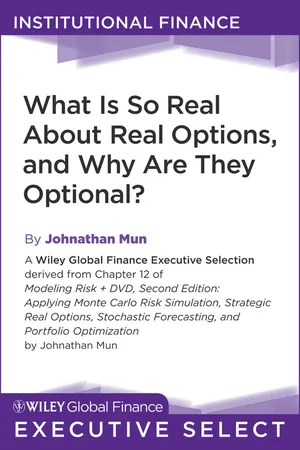
- English
- ePUB (mobile friendly)
- Available on iOS & Android
What Is So Real About Real Options, and Why Are They Optional?
About this book
In the past, corporate investment decisions were cut and dried. Buy a new machine that is more efficient, make more products costing a certain amount, and if the benefits outweigh the costs, execute the investment. Hire a larger pool of sales associates, expand the current geographical area, and if the marginal increase in forecast sales revenues exceeds the additional salary and implementation costs, start hiring. Need a new manufacturing plant? Show that the construction costs can be recouped quickly and easily by the increase in revenues the plant will generate through new and improved products, and the initiative is approved.
However, real-life business conditions are a lot more complicated. Your firm decides to go with an e-commerce strategy, but multiple strategic paths exist. Which path do you choose? What are the options you have? If you choose the wrong path, how do you get back on the right track? How do you value and prioritize the paths that exist? You are a venture capitalist firm with multiple business plans to consider. How do you value a start-up firm with no proven track record? How do you structure a mutually beneficial investment deal? What is the optimal timing to a second or third round of financing?
This chapter provides a novel approach to applying real options to answering these issues and more.
Frequently asked questions
- Essential is ideal for learners and professionals who enjoy exploring a wide range of subjects. Access the Essential Library with 800,000+ trusted titles and best-sellers across business, personal growth, and the humanities. Includes unlimited reading time and Standard Read Aloud voice.
- Complete: Perfect for advanced learners and researchers needing full, unrestricted access. Unlock 1.4M+ books across hundreds of subjects, including academic and specialized titles. The Complete Plan also includes advanced features like Premium Read Aloud and Research Assistant.
Please note we cannot support devices running on iOS 13 and Android 7 or earlier. Learn more about using the app.
Information
Table of contents
- Cover
- Title Page
- Copyright
- Part Seven: Risk Mitigation